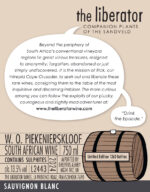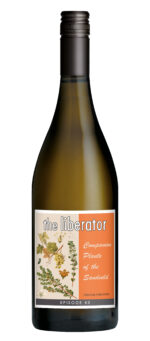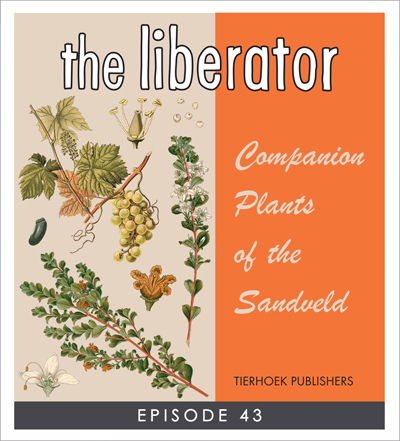Episode 43 – Companion Plants of the Sandveld
Technical Information:
| Producer: | Tierhoek |
| The Wine: | Sauvignon Blanc |
| Vintage: | 2024 |
| Wine of Origin: | Piekenierskloof |
| Alcohol: | 13.5% |
| Bottles: | 1260 bottles |
| Released: | September 2024 |
First, you have to get there…
The road to Piekenierskloof is an interesting one. Take the N7 out of Cape Town and head north for a couple of hours, skirting the towns of Malmesbury and Picketberg. Beyond there, the road starts to climb and wind up the slopes of the Piekenierskloof Pass. At the summit there’s a left turn…
From this point onwards, the road rises to the edge of the Cederberg Mountain range. It’s here, after some thirty Kilometres, that you find the modest signage directing you to Tierhoek.
 It’s a remote spot, cold, misty and rainy in winter, perhaps mixed with some snow too. Summers are long and tempered by the cool influence of the South Atlantic breeze, ensuring the resulting wines are bright, fresh and demonstrate incredible clarity.
It’s a remote spot, cold, misty and rainy in winter, perhaps mixed with some snow too. Summers are long and tempered by the cool influence of the South Atlantic breeze, ensuring the resulting wines are bright, fresh and demonstrate incredible clarity.
This is an extreme place to chance with viticulture. The previous owners of this original Sandveld farm had abandoned their vineyards in favour of citrus, rooibos and buchu…
Historically, these grapes would have been delivered down the mountain to the local Citrusdal co-operative where, at best, they would have been converted into a serviceable, if unexciting white wine before being sold off to one of the large negociants. At worst, they would be committed for distillation, destined for brandy.
The demise of the old co-op and a less unregulated industry, combined with the enthusiasm of the new generation of ‘rock-star’ winemakers determined to source the best possible fruit have changed the fortunes of regions like the Piekenierskloof within the past two decades.
Rick first travelled the road to Piekenierskloof in late 2003. Intrigued by a story recounted by an old friend. And so, with the promise of rediscovering some lost vineyards, our Cape Crusader set off in his standard issue Toyota Corroded hire car in search of this remote farm.
What he found was a revelation; not only old vine Chenin, but new plantings of Chardonnay, and Sauvignon Blanc, with a smattering of Grenache and Mourvèdre for good measure.
Some twenty years on, the old dirt road might now be tarred, and the vineyards mature, yet Rick still makes his annual pilgrimage up to the valley to check out the vineyards and the resulting wines.
As for Episode 43, could this really be the first ever single varietal Sauvignon Blanc Liberator release…? And a barrel-fermented example, at that.
The complexity found within this wine is defined by considering the holistic view of its provenance and the symbiotic influence of the immediate environment. There is one single factor here which Rick believes helps to produce a wine that is significantly greater than the sum of its parts.
That element is buchu (boegoe in Afrikaans or, to give it its scientific name: Agathosma betulina). Buchu is a traditional healing herb which is also part of the fynbos kingdom of plants. It is endemic to the south-western Cape. Rare and incredibly site specific, its oil was literally once worth its weight in gold. It is said that one could trade a whole sheep for just one thimbleful of its unctuous extract.
At Tierhoek, the buchu grows in a very thin cordon directly above the Sauvignon Blanc vineyard. Pick a sprig and rub the leaves and the plant emits an immediate powerful scent of menthol or eucalypt. One can sense the same aromas locked into the flavour profile of the wine, much in the same way as the Heitz’s much-famed ‘Martha’s Vineyard’ Napa Valley Cabernet Sauvignon is said to be influenced by the grove of eucalyptus trees that surrounds the parcel of vines.
Episode 43 represents just three 300 litre barrels of the 2024 vintage Sauvignon Blanc, influenced by the coincidental companionship of the native buchu.
It’s the reason why Rick decided to christen this release Companion Plants of the Sandveld as a homage to Hilda Mason and her book ‘Western Cape Sandveld Flowers’. It contains 85 watercolour illustrations of indigenous flora to be found in this specific part of the Cape West Coast. First published in 1972, the book is now out of print.




